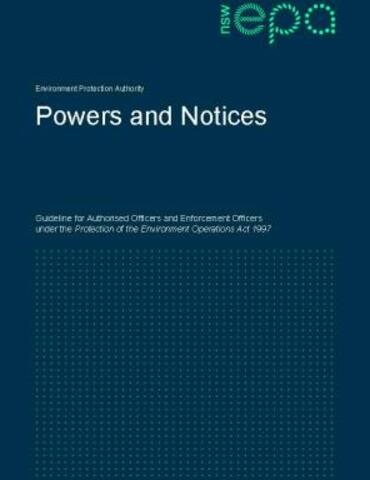Powers and notices guideline for authorised officers and enforcement officers
The Powers and Notices Guideline for Authorised Officers and Enforcement Officers (PDF 2MB) aims to help relevant officers to consistently and lawfully use their powers under the POEO Act and guide officers undertaking regulatory functions under environment protection legislation. It provides:
- additional detail to guide officers undertaking regulatory functions
- summaries of relevant case law and other examples.
The guideline replaced previous EPA guides Powers of Authorised Officers 2006 and the Guide to Notices 2009.
This guideline was recently updated to reflect changes made to the POEO Act and other environment protection legislation in early 2024. See What’s new in law for more information on the key legislation changes.
These templates may assist officers or regulatory authorities in drafting common notice types (under the POEO Act).
- s 91 clean-up notice template (PDF 332KB)
- s 91 illegal dumping clean-up notice template (PDF 376KB)
- s 91A supplementary clean-up notice template (PDF 468KB)
- s 96 prevention notice template (PDF 240KB)
- s 96A supplementary prevention notice template (PDF 351KB)
- s 104 (1) compliance cost notice template (PDF 113KB)
- s 104 (2) compliance cost notice template (PDF 153KB)
- s 104 (3) compliance cost notice template (PDF 163KB)
- s 192 request for information and records notice template (ARAs other than the EPA) (PDF 358KB)
- s 193 request for information and records notice template (authorised officers) (PDF 349KB)
- s 203 (2) notice to nominate corporate representative template (PDF 183KB)
- s 203 (5) and (6)(b) notice to nominate time and place to answer questions template (PDF 313KB)
- s 264 noise control notice template (PDF 137KB)
- s 267B compliance cost notice template (noise) (PDF 97KB)
- s 276 noise abatement direction template (PDF 133KB)*
* Note that Noise Abatement Directions may be issued verbally or in writing. If a verbal direction is given, it must include all the information contained within the written template. It is recommended that authorised officers proposing to issue directions verbally prepare a template or script card based on the written notice template to ensure that verbal directions include the required information.
Email [email protected] for more information on the guideline or notice templates.
We continue to take into account feedback from prior consultation with local government when making updates to the guideline and when developing other resources and information on powers and notices. If you would like to provide feedback on these resources, please email [email protected].
Training can help build capacity of investigation skills and techniques. Officers can register on the NSW EPA Learning website and enrol in courses directly. The courses available will be updated regularly. See Training for authorised officers and environmental regulators for more information.
Note: No representation is made about the accuracy, completeness or suitability of the information in the guideline, notice templates or any further companion materials yet to be developed for any particular purpose. Compliance with the guideline, notice templates or further companion materials may not be possible or appropriate in particular cases. Readers should not rely on the guideline, notice templates or further companion materials as indicating the procedure that appropriate regulatory authorities, authorised officers and enforcement officers will follow in all cases. Readers should seek appropriate advice, including their own legal advice, when applying the information to their specific needs.
Download

Powers and Notices Guideline Powers and Notices Guideline
